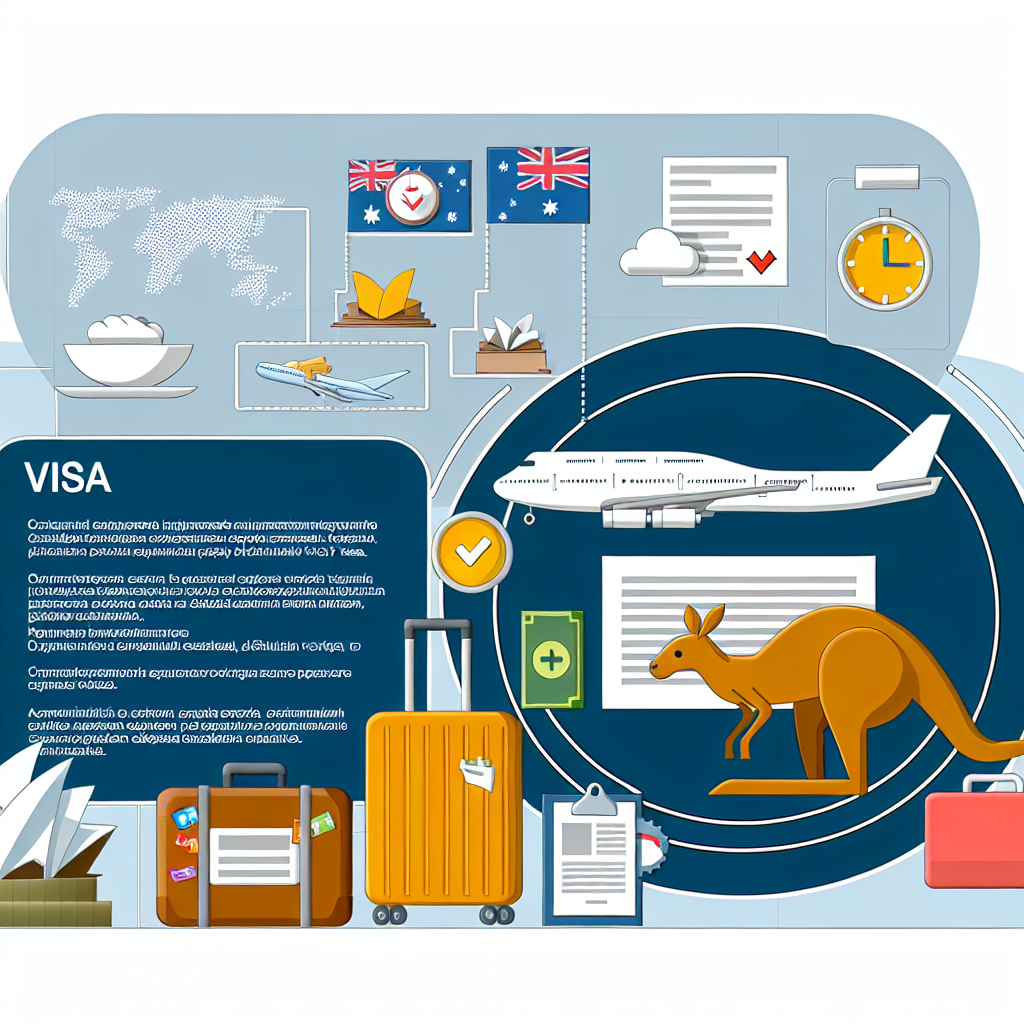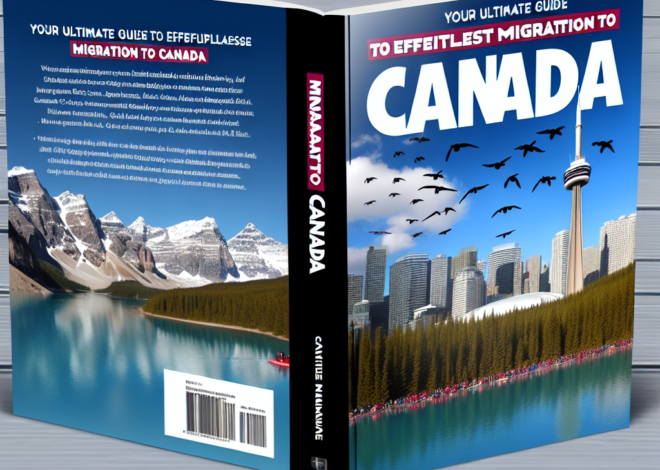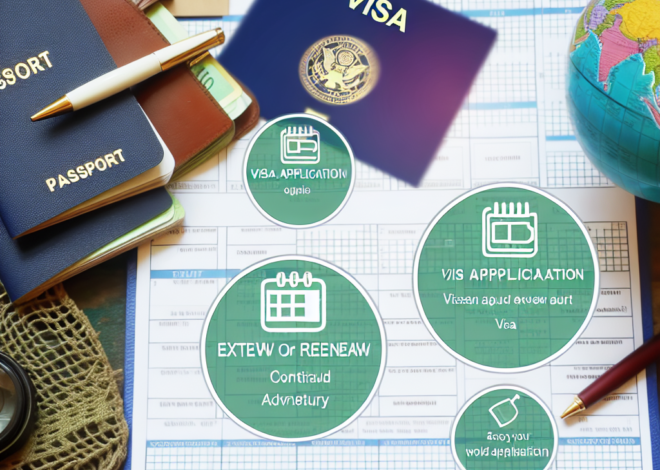
Understanding the visa requirements for Australian work visa
-
Table of Contents
“Navigate Your Path to Working Down Under: Mastering Australian Visa Requirements”
Introduction
Understanding the visa requirements for an Australian work visa is crucial for anyone planning to work in Australia. These requirements are designed to ensure that individuals entering the country for employment purposes meet specific criteria set by the Australian government. The visa process involves various types of visas, each tailored to different employment situations, such as skilled workers, seasonal labor, or intra-company transfers. Applicants must navigate through eligibility criteria, documentation, and application procedures to successfully obtain the right to work in Australia. This introduction aims to provide an overview of these requirements, helping prospective workers prepare for their application and understand the legal framework governing their employment in Australia.
Navigating the Different Types of Australian Work Visas
Understanding the visa requirements for Australian work visas is crucial for anyone looking to engage in employment in Australia, whether temporarily or permanently. Australia offers a variety of work visas, each tailored to meet specific needs and circumstances, ranging from short-term assignments to long-term employment and permanent residency. Navigating through these options requires a clear understanding of what each visa entails and how they differ from one another.
The Temporary Skill Shortage visa (subclass 482), commonly known as the TSS visa, is one of the most popular Australian work visas. It allows Australian employers to sponsor a skilled worker when they cannot find an appropriately skilled Australian citizen or permanent resident to fill the job. This visa involves a three-step process: the sponsor needs to be approved, the nominated position must be validated, and the visa applicant must then apply for the visa itself. The TSS visa is divided into short-term and medium-term streams, each with its own list of eligible occupations and validity periods, which can significantly impact the planning of both employers and employees.
Transitioning from the TSS visa, individuals may consider the Employer Nomination Scheme (ENS) visa (subclass 186), which offers a more permanent solution. This visa requires the applicant to be nominated by an Australian employer and work in a position within their business on a full-time basis. The ENS visa is particularly attractive because it leads directly to permanent residency. Applicants must meet specific skills, qualifications, and English language requirements, and the position being nominated must align with certain occupational guidelines and market salary rates.
Another pathway is the Regional Sponsored Migration Scheme (RSMS) visa (subclass 187), which also leads to permanent residency. This visa encourages skilled workers to live and work in regional or low-population growth areas of Australia. Similar to the ENS visa, the RSMS requires a job offer and a nomination by an approved Australian employer in a regional area. The requirements and processes can be complex, reflecting the government’s aim to balance regional development with immigration policy.
For those looking at establishing a business or investing in Australia, the Business Innovation and Investment (Provisional) visa (subclass 188) is an option. This visa has several streams, including the Business Innovation stream and the Investor stream, each designed to cater to different categories of entrepreneurs and investors. The criteria for this visa are stringent, requiring applicants to demonstrate a successful business or investment history, and a genuine intention to continuously maintain business or investment activity in Australia.
Lastly, the Working Holiday visa (subclass 417) and Work and Holiday visa (subclass 462) are options for younger individuals from eligible countries who wish to work and travel in Australia for up to a year. These visas offer a unique opportunity for cultural exchange and are less focused on long-term employment but rather on short-term, casual work to support travel.
In conclusion, understanding the various Australian work visas is essential for planning your career path or business strategy in Australia. Each visa has specific requirements, processes, and intended outcomes, making it important to carefully assess which visa best aligns with your professional goals and personal circumstances. Whether seeking temporary work or permanent residency, the right information and preparation can pave the way for a successful application and a fruitful career in Australia.
Essential Documents and Preparations for Australian Work Visa Applications
Understanding the visa requirements for Australian work visas is a critical step for anyone looking to work in Australia. The process involves meticulous preparation and a thorough understanding of the necessary documents required to ensure a successful application. This article aims to guide potential applicants through the essential documents and preparations needed for Australian work visa applications.
Firstly, the cornerstone of any visa application is a valid passport. Applicants must ensure that their passport is valid for at least six months beyond the date they plan to leave Australia. This is crucial as it forms the basis of identity verification and is required at every stage of the visa application process.
Following the passport, the next significant document is the visa application form itself. It is vital to complete this form accurately and truthfully, as any discrepancies can lead to delays or rejection of the application. The form asks for personal information, details about your intended employment, and your health and character certifications. It is advisable to review the form several times before submission to ensure all information is correct and complete.
Another critical aspect of the application is proof of financial means. This is to assure the Australian government that the applicant can support themselves during their stay. Bank statements, pay slips, or a financial guarantee from an Australian sponsor are commonly used to fulfill this requirement. The exact requirements can vary depending on the specific work visa subclass being applied for.
Employment documentation is equally important. This includes a job offer letter from an Australian employer, which should clearly state the terms and conditions of employment, such as the role, salary, and duration of the job. For certain visas, like the Temporary Skill Shortage visa (subclass 482), the employer must also demonstrate that they have tested the local labor market and that there is a genuine need for an overseas worker to fill the role.
In addition to these documents, applicants must also provide evidence of their qualifications and work experience. This typically includes academic transcripts, professional licenses, and letters of reference from previous employers. These documents should corroborate the applicant’s ability to perform the job they are being hired for in Australia.
Health and character assessments are another crucial part of the application process. Applicants might need to undergo a medical examination by a doctor approved by the Australian government. Similarly, police certificates may be required to assess the character of the applicant. These certificates should be from every country the applicant has lived in for 12 months or more during the past ten years.
Lastly, preparing for a visa interview, if required, is an essential step. Not all work visas require an interview, but if one is necessary, the applicant should be prepared to discuss their qualifications, background, and reasons for wanting to work in Australia. It is important to be honest and clear in your responses during the interview.
In conclusion, preparing an application for an Australian work visa requires careful attention to detail and thorough preparation of a range of documents. From ensuring that your passport is up to date to gathering employment documents and undergoing health checks, each step is integral to proving eligibility and intent. By meticulously preparing and organizing the required documents, applicants can streamline their visa application process, thereby enhancing their chances of success in obtaining permission to work in Australia.
Understanding the Role of Sponsorship in Australian Work Visas
Understanding the visa requirements for an Australian work visa can be a complex process, particularly when it comes to comprehending the role of sponsorship. Sponsorship is a pivotal element in the Australian work visa framework, serving as a bridge that connects Australian employers with foreign workers whose skills are in demand. This connection not only supports the Australian economy but also provides opportunities for skilled workers from around the globe.
To begin with, it is essential to recognize that sponsorship under Australian work visas typically involves an Australian employer nominating a foreign employee to work in Australia. This is most commonly seen in the Temporary Skill Shortage (TSS) visa (subclass 482) and the Employer Nomination Scheme (ENS) visa (subclass 186). Each of these visas has specific criteria and purposes, tailored to meet the needs of the Australian labor market.
The process starts when an employer identifies a gap in their workforce that cannot be filled by the local labor market. In such cases, employers can look overseas and nominate a candidate to fill the position. However, before this can happen, the employer must become an approved sponsor. Gaining approval involves meeting various requirements, including demonstrating a commitment to training local employees and ensuring that the business is lawfully operating in Australia. This ensures that the sponsorship program is used appropriately and benefits the Australian economy.
Once approved, sponsors have certain obligations, including ensuring that foreign workers receive the same terms and conditions of employment as their Australian counterparts. This is crucial in maintaining fair work practices and protecting the rights of overseas workers. Additionally, the sponsored position must align with the skills and qualifications of the visa applicant, and it must pay a salary that meets the minimum wage standards set for the industry. This safeguards against the exploitation of foreign workers and ensures that they are being hired for their skills and not as a means to reduce labor costs.
Moreover, the role of sponsorship extends beyond merely filling a position. It involves a commitment from the employer to support the visa holder for the duration of their visa. This includes providing assistance with the visa application process and helping the employee understand their rights and obligations while working in Australia. The relationship between the sponsor and the visa holder is thus characterized by mutual responsibilities and benefits, creating a system that supports both the employer and the employee.
Furthermore, the importance of sponsorship in Australian work visas is underscored by the government’s monitoring and compliance activities. Authorities regularly check to ensure that sponsors and visa holders comply with their obligations. Non-compliance can lead to sanctions against the employer, including cancellation of the sponsorship and fines, which underscores the seriousness of the sponsorship role.
In conclusion, sponsorship is a fundamental aspect of the Australian work visa system. It not only helps fill skill shortages in the Australian labor market but also provides a structured and regulated pathway for skilled workers to enter Australia. For employers, becoming a sponsor involves a series of responsibilities but offers the reward of tapping into a global talent pool. For foreign workers, obtaining a sponsored visa is a gateway to new opportunities in Australia, making understanding the intricacies of sponsorship all the more crucial for both parties involved.
Tips for Successfully Meeting Australian Work Visa Requirements
Understanding the visa requirements for an Australian work visa can be a complex process, but with the right information and preparation, you can navigate it successfully. Australia offers various types of work visas, each designed to cater to different professional circumstances and goals. Whether you are planning to engage in short-term work or seeking permanent residency through employment, knowing the specific requirements and tips to meet them is crucial.
Firstly, it is essential to identify the correct type of work visa that aligns with your career objectives and duration of stay. The most common types include the Temporary Skill Shortage visa (subclass 482), which allows employers to address labour shortages by bringing in skilled workers where no skilled Australian workers are available, and the Skilled Independent visa (subclass 189) for skilled workers who are not sponsored by an employer or family member or nominated by a government.
Once you have determined the appropriate visa, the next step involves understanding the criteria, which typically includes age, language proficiency, and skilled employment experience. For instance, most skilled visas require applicants to pass a points test. Points are awarded based on factors such as age, English language ability, skilled employment experience, and educational qualifications. Preparing to meet these criteria involves gathering substantial documentation, such as proof of identity, letters of employment, and qualification assessments.
Language proficiency is another critical requirement. Most Australian work visas require proof of English language skills. Tests like IELTS or TOEFL are commonly accepted, and achieving a good score can significantly enhance your application. Therefore, investing time in preparing for these tests is advisable, as it not only helps in meeting visa requirements but also in easing your integration into the Australian workplace and community.
Moreover, the importance of accurate and thorough documentation cannot be overstressed. The Australian Department of Home Affairs scrutinizes all applications meticulously. Incomplete or incorrect documentation can lead to delays or even visa denial. It is advisable to double-check all entries and ensure that all required documents are attached before submission. In some cases, seeking professional help from registered migration agents can provide guidance and increase the likelihood of a successful application.
Another vital aspect is to stay updated with the latest immigration laws and regulations, which can change frequently. Keeping abreast of any changes ensures that you are meeting the current requirements, thus avoiding any potential setbacks due to outdated information.
Finally, it is crucial to plan your application well in advance of your intended travel date. Processing times can vary widely depending on the visa category and the volume of applications being handled. Early preparation allows you to rectify any shortcomings in your application and also provides a buffer in case of unexpected delays.
In conclusion, successfully applying for an Australian work visa requires careful consideration and preparation. By understanding and meticulously preparing to meet the visa requirements, and staying informed about the latest immigration policies, you can enhance your chances of approval. Remember, a well-prepared visa application is the first step towards a successful career in Australia.



